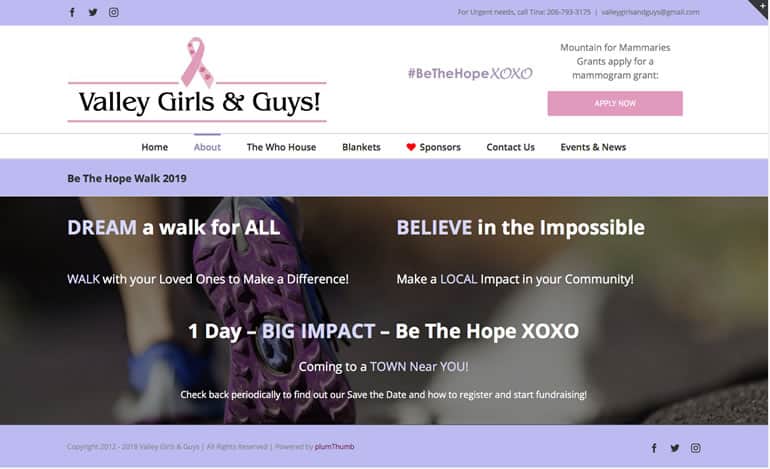
We are in the final countdown for the first ever “Be the Hope XOXO” walk for all cancers here in our very own Maple Valley. Created by the Valley Girls and Guys, this walk is raising money for cancer awareness, treatment, and research that stays in our local community. PT4EB is honored to be a part of the post-walk treatment team offering free calf, quad, and hamstring massages to all the walkers.
What does it take to train for an 18 mile walk?
The following are the top 5 tips to keep in mind before beginning a walking program.
1) Start with the right shoes – Many people believe that walking can be done in just any shoes but I guarantee bad shoes lead to foot, knee, hip, and low back problems in the future. Start yourself off on the right foot by heading out to find a pair of proper walking shoes for you. In general you are looking for a good level of support balanced with cushion to help absorb the shock. If you are planning on spending most of your time on trails, look into a trail shoe that has a better sole to handle the rougher roads.
2) Use a comfortable pace – When you are beginning a new program you may be very excited and ready to charge forward. This can lead to quick injuries that will end up sidelining you for so long that you lose your motivation. Start with a pace that gets your heart rate up but you can easily talk through.
3) Grab a friend – Having someone on this journey with you gives you someone to talk to during your walks to make sure that you are keeping your breathing steady. It will also help increase your accountability. Have you ever said you were going to start a walking program only to find that months later you still hadn’t started? Having a partner can help keep you accountable. You can even enlist your dog to help. Once they get used to daily walks they can be great motivators to keep you going!
4) Drink more water – The great thing about exercising is that it makes us thirsty, so we want to drink more water. Make sure you are drinking enough water to meet your increasing exercise demands. How much is enough? Well, there are several formulas but I prefer to keep it simple. Drink enough water that your pee is clear and then keep drinking water to keep it clear.
5) Keep going and progress regularly – If you are new to exercise, or it has been awhile since you have used a regular exercise program, start off with 1-2 miles a few times per week. As you build up your endurance, add ½-1 mile per week. When you increase your distance you might have some increased muscle soreness, but you should not have increased pain in your muscles or joints.
Muscle soreness is normal after starting an exercise routine but pain is another matter completely. Muscle soreness feels better after you are moving around and stretching out. Pain may increase the more you move. Painful muscles do not like to be stretched. Stretching them may actually make the pain even worse.
If you find yourself having increased pain with a new exercise program we can help with that. We will help locate what is causing the pain and get you on a personalized plan to get you back to your training program. At PT4EB we believe that movement is life. So, we design all of our treatments and exercise programs to get you back to the movements your life requires.
For all those who are joining this walk, we here at PT4EB give you a standing ovation. We hope you will come see us after your walk to help work out any muscle soreness in your calves and legs. Or just stop by so we can give you a high five and thank you for walking.



